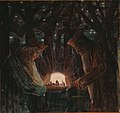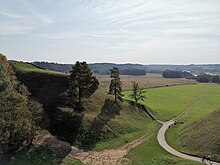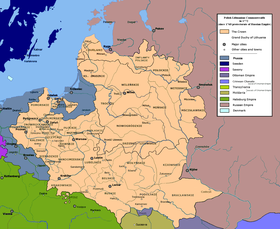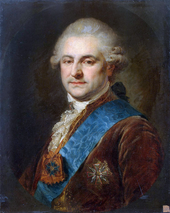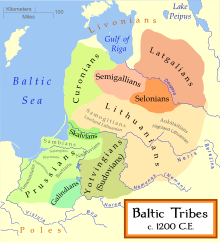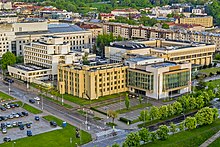Template:Transclude list item excerpts as random slideshow/testcases/Portal:Lithuania
| This is the template test cases page for the sandbox of Template:Transclude list item excerpts as random slideshow/testcases. Purge this page to update the examples. If there are many examples of a complicated template, later ones may break due to limits in MediaWiki; see the HTML comment "NewPP limit report" in the rendered page. You can also use Special:ExpandTemplates to examine the results of template uses. You can test how this page looks in the different skins and parsers with these links: |
Portal maintenance status: (June 2018)
|
Introduction
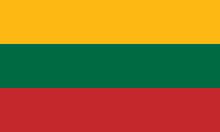
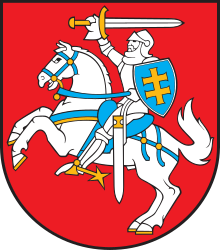
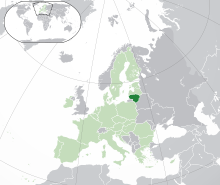
Lithuania, officially the Republic of Lithuania, is a country in the Baltic region of Europe. It is one of three Baltic states and lies on the eastern shore of the Baltic Sea, bordered by Latvia to the north, Belarus to the east and south, Poland to the south, and the Russian semi-exclave of Kaliningrad Oblast to the southwest, with a maritime border with Sweden to the west. Lithuania covers an area of 65,300 km2 (25,200 sq mi), with a population of 2.89 million. Its capital and largest city is Vilnius; other major cities include Kaunas, Klaipėda, Šiauliai and Panevėžys. Lithuanians belong to the linguistic group of the Balts and speak Lithuanian.
For millennia, the southeastern shores of the Baltic Sea were inhabited by various Baltic tribes. In the 1230s, Lithuanian lands were united for the first time by Mindaugas, who formed the Kingdom of Lithuania on 6 July 1253. Subsequent expansion and consolidation resulted in the Grand Duchy of Lithuania, which by the 14th century was the largest country in Europe. In 1386, the Grand Duchy entered into a de facto personal union with the Crown of the Kingdom of Poland. The two realms were united into the bi-confederal Polish-Lithuanian Commonwealth in 1569, forming one of the largest and most prosperous states in Europe. The Commonwealth lasted more than two centuries, until neighbouring countries gradually dismantled it between 1772 and 1795, with the Russian Empire annexing most of Lithuania's territory.
Towards the end of World War I, Lithuania declared Independence in 1918, founding the modern Republic of Lithuania. In World War II, Lithuania was occupied by the Soviet Union, then by Nazi Germany, before being reoccupied by the Soviets in 1944. Lithuanian armed resistance to the Soviet occupation lasted until the early 1950s. On 11 March 1990, a year before the formal dissolution of the Soviet Union, Lithuania became the first Soviet republic to break away when it proclaimed the restoration of its independence. (Full article...)
Selected pictures
-
Image 2Panorama of Vilnius in 1600 (from Lithuania)
-
Image 5Le Château — Conte de fées (Lithuanian: Pilis — Pasaka) by Mikalojus Konstantinas Čiurlionis (1909) (from Culture of Lithuania)
-
Image 6Statutes of Lithuania were the central piece of Lithuanian law in 1529–1795. (from Lithuania)
-
Image 7Simple Words of Catechism by Martynas Mažvydas was the first Lithuanian book and was published in 1547. (from Culture of Lithuania)
-
Image 13The white stork is the national bird of Lithuania, which has the highest-density stork population in Europe. (from Lithuania)
-
Image 15Real GDP per capita development of Estonia, Latvia and Lithuania (from Lithuania)
-
Image 17A ceremony of Lithuanian modern pagans. (from Culture of Lithuania)
-
Image 18The first Lithuanian printed book, Catechism of Martynas Mažvydas (1547, Königsberg) (from Lithuania)
-
Image 20Lithuanian counties by GDP per capita, 2022 (from Lithuania)
-
Image 22Chapel of Saint Casimir, the patron saint of Lithuania and Lithuanian youth, with his sarcophagus in the centre (from Lithuania)
-
Image 25Traditional Lithuanian house from late 19th century (from Culture of Lithuania)
-
Image 26Guests of the 2023 Vilnius (NATO) summit in the Courtyard of the Presidential Palace in Vilnius (from Lithuania)
-
Image 30Lithuanian cemetery at All Souls night (from Culture of Lithuania)
-
Image 33Population density in Lithuania by elderships (from Lithuania)
-
Image 35Cepelinai served with sour cream (from Culture of Lithuania)
-
Image 36The earliest known Lithuanian glosses (between 1520 and 1530) written in the margins of Johann Herolt book Liber Discipuli de eruditione Christifidelium. Words: teprÿdav[ſ]ʒÿ (let it strike), vbagÿſte (indigence). (from Lithuania)
-
Image 37Lithuanian Army soldiers marching with their dress uniforms in Vilnius. An officer stands out with a sword. (from Lithuania)
-
Image 40Lithuania was a member of the United Nations Security Council. Its representatives are on the right side. (from Lithuania)
-
Image 41Lithuania's name in writing (Litua, on line 7), 1009 (from Lithuania)
-
Image 45Members of the Council of Lithuania after signing the Act of Independence of Lithuania in 1918 (from Lithuania)
-
Image 47The Great Courtyard of Vilnius University and the Church of St. Johns (from Culture of Lithuania)
-
Image 48Physical map and geomorphological subdivision of Lithuania (from Lithuania)
-
Image 52Vilnius University, one of the oldest universities in the region. It was established by Stephen Báthory, King of Poland and Grand Duke of Lithuania, in 1579. (from Lithuania)
-
Image 54Stamp dedicated to Lithuania's presidency of the European Union. Post of Lithuania, 2013. (from Lithuania)
-
Image 56Rock band Antis, which under firm censorship actively mocked the Soviet Union regime by using metaphors in their lyrics, during an anti-Sovietism, anti-communism concert in 1987 (from Lithuania)
-
Image 57Lithuania's GDP per capita compared to rest of the world (2022) (from Lithuania)
-
Image 59Cepelinai, a potato-based dumpling dish characteristic of Lithuanian cuisine with meat, curd or mushrooms (from Lithuania)
-
Image 60Lithuanian artist Jonas Mekas, regarded as godfather of American avant-garde cinema (from Culture of Lithuania)
-
Image 61The title page of Radivilias (1592, Vilnius). The poem celebrating commander Mikalojus Radvila Rudasis (1512–1584) and recounts the famous victory of Lithuanian Armed Forces over Moscow troops (1564). (from Lithuania)
-
Image 65Lithuania men's national basketball team is ranked eighth worldwide in FIBA Rankings. (from Lithuania)
-
Image 71Lithuanian basketball clubs Žalgiris and Šiauliai playing a match (from Culture of Lithuania)
-
Image 76Changes in the territory of Lithuania from the 13th to 15th century. At its peak, Lithuania was the largest state in Europe. (from Lithuania)
-
Image 79Trakai Island Castle, the former residence of the Grand Dukes. Trakai was the capital of the medieval state. (from Lithuania)
-
Image 80Baltic amber was a valuable trade item, transported from the region of modern-day Lithuania to the Roman Empire through the Amber Road. (from Lithuania)
-
Image 81Major highways in Lithuania (from Lithuania)
-
Image 84Emilia Plater leading peasant scythemen during the 1831 Uprising against Russian Empire; often nicknamed as a Lithuanian Joan of Arc (from Lithuania)
-
Image 86Gryčia (traditional dwelling house, built in the 19th century) (from Lithuania)
-
Image 87Commemoration of the Act of the Re-Establishment of the State of Lithuania in the historical Seimas hall where it was originally signed in 1990. The ceremony is attended by the Lithuanian President, Prime Minister, Chairman of the Seimas and other high-ranking officials. (from Lithuania)
Selected county
-
Image 1
Telšiai County (Lithuanian: Telšių apskritis) is one of ten counties in Lithuania. It is in the west of the country, and its capital is Telšiai. There are Lithuanians (98.7%), Latvians (0.1%), Russians (0.9%), and others (0.3%). On 1 July 2010, the county administration was abolished, and since that date, Telšiai County remains as the territorial and statistical unit. It borders Latvia. (Full article...) -
Image 2
Panevėžys County (Lithuanian: Panevėžio apskritis) is one of ten counties in Lithuania. It is in the north-east of the country, and its capital is Panevėžys. On 1 July 2010, the county administration was abolished, and since that date, Panevėžys County remains as the territorial and statistical unit. (Full article...) -
Image 3
Marijampolė County (Lithuanian: Marijampolės apskritis) is one of the ten counties in Lithuania. It is in the southwest of the country and roughly corresponds to the historical region of Sudovia. Its capital and the largest town is Marijampolė. On 1 July 2010, the county administration was abolished, and since that date, Marijampolė County remains as the territorial and statistical unit.
It borders the Tauragė County in the north, Kaunas County and Alytus County in the east, Podlaskie Voivodeship of Poland in the south and Kaliningrad Oblast of Russia in the west. (Full article...) -
Image 4
Šiauliai County (Lithuanian: Šiaulių apskritis) is one of ten counties in Lithuania. It is in the north of the country, and its capital is Šiauliai. On 1 July 2010, the county administration was abolished, and since that date, Šiauliai County remains as the territorial and statistical unit. It borders Latvia. (Full article...) -
Image 5
Alytus County (Lithuanian: Alytaus apskritis) is one of ten counties in Lithuania. It is the southernmost county, and its capital is the city of Alytus. Its territory lies within the ethnographic region of Dzūkija. On 1 July 2010, the county administration was abolished, and since that date, Alytus County remains as the territorial and statistical unit.
It borders the Vilnius County in the east, Marijampolė County and Kaunas County in the north, Podlaskie Voivodeship of Poland in the west, and Grodno Region of Belarus in the south. (Full article...) -
Image 6
Vilnius County (Lithuanian: Vilniaus apskritis) is the largest of the 10 counties of Lithuania, located in the east of the country around the city Vilnius and is also known as Capital Region or Sostinės regionas by the Lithuanian statistics department and Eurostat. On 1 July 2010, the county administration was abolished, and since that date, Vilnius County remains as the territorial and statistical unit. (Full article...) -
Image 7
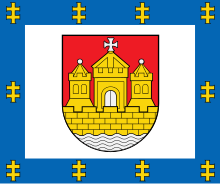
Klaipėda County (Lithuanian: Klaipėdos apskritis) is one of ten counties in Lithuania, bordering Tauragė County to the southeast, Telšiai County to the northeast, Kurzeme in Latvia to the north, and Kaliningrad Oblast in Russia to the south. To the west is the Baltic Sea. It lies in the west of the country and is the only county to have a coastline and not be landlocked. Its capital is Klaipėda. On 1 July 2010, the county administration was abolished, and since that date, Klaipėda County remains as the territorial and statistical unit. (Full article...) -
Image 8
Tauragė County (Lithuanian: Tauragės apskritis) is one of ten counties in Lithuania. It is in the west of the country, and its capital is Tauragė. On 1 July 2010, the county administration was abolished, and since that date, Tauragė County remains as the territorial and statistical unit.
Famous landmarks include Tauragė Castle and Panemunė Castle. (Full article...) -
Image 9
Utena County (Lithuanian: Utenos Apskritis) is one of ten counties in Lithuania. It is the country's most sparsely populated county. The capital and the largest city in the county is Utena, which is 95 km (59 mi) from Vilnius, the capital of Lithuania. On 1 July 2010, the county administration was abolished. Since that date, Utena County remains as the territorial and statistical unit. It borders Latvia. (Full article...) -
Image 10
Kaunas County (Lithuanian: Kauno apskritis) is one of ten counties of Lithuania. It is in the centre of the country, and its capital is Kaunas. On 1 July 2010, the county administration was abolished. (Full article...)
Selected municipality
-
Image 1

Druskininkai Municipality (Lithuanian: Druskininkų savivaldybė) is a municipality in Alytus County, Lithuania. (Full article...) -
Image 2
Kaunas (/ˈkaʊnəs/; Lithuanian: [ˈkɐʊ̯ˑnˠɐs] ⓘ; previously known in English as Kovno /ˈkɒvnoʊ/) is the second-largest city in Lithuania after Vilnius, the fourth largest city in the Baltic States and an important centre of Lithuanian economic, academic, and cultural life. Kaunas was the largest city and the centre of a county [pl] in the Duchy of Trakai of the Grand Duchy of Lithuania and Trakai Palatinate since 1413. In the Russian Empire, it was the capital of the Kaunas Governorate from 1843 to 1915.
During the interwar period, it served as the temporary capital of Lithuania, when Vilnius was seized and controlled by Poland between 1920 and 1939. During that period Kaunas was celebrated for its rich cultural and academic life, fashion, construction of countless Art Deco and Lithuanian National Revival architectural-style buildings as well as popular furniture, interior design of the time, and a widespread café culture. The city interwar architecture is regarded as among the finest examples of European Art Deco and has received the European Heritage Label. It contributed to Kaunas being designated as the first city in Central and Eastern Europe as a UNESCO City of Design, and also to becoming a World Heritage Site in 2023 as the only European city representing large scale urbanization during the interwar period and versatile modernism architecture. (Full article...) -
Image 3
Lazdijai District Municipality (Lithuanian: Lazdijų rajono savivaldybė) is a municipality in Alytus County, Lithuania. (Full article...) -
Image 4

Klaipėda (/ˈkleɪpɛdə/ CLAY-ped-ə; Lithuanian: [ˈklˠɐɪ̯ˑpʲeːdˠɐ] ⓘ) is a city in Lithuania on the Baltic Sea coast. It is the third largest city in Lithuania, the fifth largest city in the Baltic States and the capital of Klaipėda County, as well as the only major seaport in the country.
The city has a complex recorded history, partially due to the combined regional importance of the usually ice-free Port of Klaipėda at the mouth of the river Akmena-Danė [lt]. Located in Lithuania Minor, and the State of the Teutonic Order and Duchy of Prussia under the suzerainty of the Polish–Lithuanian Commonwealth, then the Kingdom of Prussia and German Empire, within which it was the northernmost big city until it was placed under French occupation in 1919. From 1923, the city was part of Lithuania until its annexation by Nazi Germany in 1939, and after World War II it was part of the Lithuanian Soviet Socialist Republic. Klaipėda has remained within Lithuania since 1944. (Full article...) -
Image 5
Kėdainiai District Municipality (Lithuanian: Kėdainių rajono savivaldybė) is one of 60 municipalities in Lithuania, located in the central part of the country. (Full article...) -
Image 6
Kalvarija Municipality (Lithuanian: Kalvarijos savivaldybė) is a municipality in Marijampolė County, south-western Lithuania, on the border with Poland. Its administrative seat and largest town is Kalvarija.
It borders Lazdijai District Municipality to the east, Vilkaviškis District Municipality to the northwest, Marijampolė Municipality to the north and the Polish voivodeship of Podlaskie to the south. (Full article...) -
Image 7Landscape near Marškonė
Mažeikiai District Municipality (Lithuanian: Mažeikių rajono savivaldybė, Samogitian: Mažėikiu rajuona savivaldībė) is located in the north-west of Lithuania, on the River Venta in Telšiai County. The administrative center of Mažeikiai District is the city of Mažeikiai. Its territory of 1,220.2 km2 (471.1 sq mi) is composed of 32 km2 (12 sq mi) of towns and settlements, 22 km2 (8.5 sq mi) of industrial enterprises and roads, 614 km2 (237 sq mi) of agricultural lands, 273 km2 (105 sq mi) of forests, and 68 km2 (26 sq mi) of tracts of other designation. There is one urban and 8 rural elderates. In 2003, the population was 67,393. Of this number, 46,223 live in towns and 21,170 in villages.
It is situated in northern Samogitia. Mažeikiai District borders with the Republic of Latvia in the north, with Akmenė District Municipality in the east, with Telšiai District Municipality in the southeast, with Plungė District Municipality in the southwest and with Skuodas District Municipality in the west. Mažeikiai District stretches for 43.5 km (27.0 mi) east-to-west and 38 km (24 mi) north-to-south. Petraičiai village is the westernmost settlement, with Kalniškiai and Pakliaupė villages being the easternmost settlements. The northernmost is Giniočiai, while the southernmost is Pasruojė. (Full article...) -
Image 8
Vilnius (/ˈvɪlniəs/ ⓘ VIL-nee-əs, Lithuanian: [ˈvʲɪlʲnʲʊs] ⓘ) is the capital of and largest city in Lithuania and the most-populous city in the Baltic states. The city's estimated January 2025 population was 607,404, and the Vilnius urban area (which extends beyond the city limits) has an estimated population of 747,864.
Vilnius is notable for the architecture of its Old Town, considered one of Europe's largest and best-preserved old towns. The city was declared a UNESCO World Heritage Site in 1994. The architectural style known as Vilnian Baroque is named after the city, which is farthest to the east among Baroque cities and the largest such city north of the Alps. (Full article...) -
Image 9
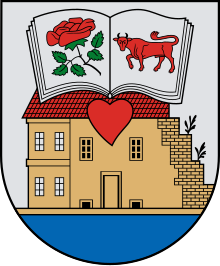
The Ukmergė District Municipality is a municipality in Vilnius County, Lithuania. The capital of the municipality is Ukmergė, the largest settlement and only city in the municipality. The entire municipality belongs to Aukštaitija ethnographic region. (Full article...) -
Image 10
Joniškis District Municipality (Joniškio rajono savivaldybė) is a territorial unit of Lithuania with a population of about 30,000. The administrative center of the municipality is the city of Joniškis. (Full article...) -
Image 11
-
Image 12
Tauragė District Municipality (Lithuanian: Tauragės rajono savivaldybė) is a municipality in Tauragė County, Lithuania
Famous landmarks include Tauragė Castle and Panemunė Castle. (Full article...) -
Image 13
Šiauliai (/ʃaʊˈleɪ/ show-LAY; Lithuanian: [ɕɛʊ̯ˈlʲɛɪ̯ˑ] ⓘ) is a city in northern Lithuania, the country's fourth largest city and the sixth largest city in the Baltic States, with a population of 112 581 in 2024. From 1994 to 2010 it was the capital of Šiauliai County. (Full article...) -
Image 14Kupa is a river flowing through Kupiškis
Kupiškis District Municipality is one of 60 municipalities in Lithuania. (Full article...) -
Image 15Migoniai mound
Pasvalys District Municipality is one of 60 municipalities in Lithuania. (Full article...)
Selected World Heritage Site
-
Image 1
Kaunas (/ˈkaʊnəs/; Lithuanian: [ˈkɐʊ̯ˑnˠɐs] ⓘ; previously known in English as Kovno /ˈkɒvnoʊ/) is the second-largest city in Lithuania after Vilnius, the fourth largest city in the Baltic States and an important centre of Lithuanian economic, academic, and cultural life. Kaunas was the largest city and the centre of a county [pl] in the Duchy of Trakai of the Grand Duchy of Lithuania and Trakai Palatinate since 1413. In the Russian Empire, it was the capital of the Kaunas Governorate from 1843 to 1915.
During the interwar period, it served as the temporary capital of Lithuania, when Vilnius was seized and controlled by Poland between 1920 and 1939. During that period Kaunas was celebrated for its rich cultural and academic life, fashion, construction of countless Art Deco and Lithuanian National Revival architectural-style buildings as well as popular furniture, interior design of the time, and a widespread café culture. The city interwar architecture is regarded as among the finest examples of European Art Deco and has received the European Heritage Label. It contributed to Kaunas being designated as the first city in Central and Eastern Europe as a UNESCO City of Design, and also to becoming a World Heritage Site in 2023 as the only European city representing large scale urbanization during the interwar period and versatile modernism architecture. (Full article...) -
Image 2The Valley of Death looking from the Parnidis Dune in Neringa Municipality, Lithuania in October 2022.
The Curonian (Courish) Spit (Lithuanian: Kuršių nerija; Russian: Ку́ршская коса́) is a 98-kilometre (61 mi) long, thin, curved sand-dune spit that separates the Curonian Lagoon from the Baltic Sea. It is a UNESCO World Heritage Site shared by Lithuania and Russia. Its southern portion lies within Kaliningrad Oblast of Russia, and its northern within southwestern Klaipėda County of Lithuania. (Full article...) -
Image 3
The Old Town of Vilnius (Lithuanian: Vilniaus senamiestis), one of the largest surviving medieval old towns in Northern Europe, as inscribed within UNESCO World Heritage Sites, has an area of 3.59 square kilometres (887 acres). It encompasses 74 quarters, with 70 streets and lanes numbering 1487 buildings with a total floor area of 1,497,000 square meters. The administrative division of the Old Town (senamiesčio seniūnija) is a larger territory and comprises more than 4.5 square kilometres. It was founded by the Lithuanian Grand Duke and King of Poland Jogaila in 1387 on the Magdeburg rights the oldest part of the Lithuanian capital of Vilnius, it had been developed over the course of many centuries, and has been shaped by the city's history and a constantly changing cultural influence. It is a place where some of Europe's greatest architectural styles—gothic, renaissance, baroque and neoclassical—stand side by side and complement each other. There are many Catholic, Lutheran and Orthodox churches, residential houses, cultural and architectural monuments, museums in the Old Town.
Pilies Street is the Old Town's main artery and the hub of cafe and street market life. The main street of Vilnius, Gediminas Avenue, is partially located in the Old Town. The central squares in the Old Town are the Cathedral Square and the Town Hall Square. (Full article...) -
Image 4The northernmost station of the Struve Geodetic Arc is located in Fuglenes, Norway.
The Struve Geodetic Arc is a chain of survey triangulations stretching from Hammerfest in Norway to the Black Sea, through ten countries and over 2,820 kilometres (1,750 mi), which yielded the first accurate measurement of a meridian arc.
The chain was established and used by the German-born Russian scientist Friedrich Georg Wilhelm von Struve in the years 1816 to 1855 to establish the exact size and shape of the earth. At that time, the chain passed merely through three countries: Norway, Sweden and the Russian Empire. The Arc's first point is located in Tartu Observatory in Estonia, where Struve conducted much of his research. Measurement of the triangulation chain comprises 258 main triangles and 265 geodetic vertices. The northernmost point is located near Hammerfest in Norway and the southernmost point near the Black Sea in Ukraine. (Full article...) -
Image 5
Kernavė was a medieval capital of the Grand Duchy of Lithuania and today is a tourist attraction and an archeological site (population 238, 2021). It is located in the Širvintos district municipality located in southeast Lithuania. A Lithuanian state cultural reserve was established in Kernavė in 1989. In 2004 Kernavė Archaeological Site was included into UNESCO World Heritage list. (Full article...)
Selected history article
-
Image 1

The Amber Road (east route), as hypothesized by Polish historian Jerzy Wielowiejski, Główny szlak bursztynowy w czasach Cesarstwa Rzymskiego (Main Route of the Amber Road of the Roman Empire), 1980
The Amber Road was an ancient trade route for the transfer of amber from coastal areas of the North Sea and the Baltic Sea to the Mediterranean Sea. Prehistoric trade routes between Northern and Southern Europe were defined by the amber trade.
As an important commodity, sometimes dubbed "the gold of the north", amber was transported from the North Sea and Baltic Sea coasts overland by way of the Vistula and Dnieper rivers to Italy, Greece, the Black Sea, Syria and Egypt over a period of thousands of years. (Full article...) -
Image 2

The Grand Duchy of Lithuania was a sovereign state in northeastern Europe that existed from the 13th century, succeeding the Kingdom of Lithuania, to the late 18th century, when the territory was suppressed during the 1795 partitions of Poland–Lithuania. The state was founded by Lithuanians, who were at the time a polytheistic nation of several united Baltic tribes from Aukštaitija. By 1440 the grand duchy had become the largest European state, controlling an area from the Baltic Sea in the north to the Black Sea in the south.
The grand duchy expanded to include large portions of the former Kievan Rus' and other neighbouring states, including what is now Belarus, Lithuania, most of Ukraine as well as parts of Latvia, Moldova, Poland and Russia. At its greatest extent, in the 15th century, it was the largest state in Europe. It was a multi-ethnic and multiconfessional state, with great diversity in languages, religion, and cultural heritage. (Full article...) -
Image 3The history of the Polish–Lithuanian Commonwealth (1569–1648) covers a period in the history of Poland and Lithuania, before their joint state was subjected to devastating wars in the mid-17th century. The Union of Lublin of 1569 established the Polish–Lithuanian Commonwealth, a more closely unified federal state, replacing the previously existing personal union of the two countries. The Union was largely run by the Polish and increasingly Polonized Lithuanian and Ruthenian nobility, through the system of the central parliament and local assemblies, but from 1573 led by elected kings. The formal rule of the nobility, which was a much greater proportion of the population than in other European countries, constituted a sophisticated early democratic system, in contrast to the absolute monarchies prevalent at that time in the rest of Europe.[a]
The Polish–Lithuanian Union had become an influential player in Europe and a significant cultural entity. In the second half of the 16th and the first half of the 17th century, the Polish–Lithuanian Commonwealth was a huge state in central-eastern Europe, with an area approaching one million square kilometers. (Full article...) -
Image 4

Lithuania, officially the Republic of Lithuania, is a country in the Baltic region of Europe. It is one of three Baltic states and lies on the eastern shore of the Baltic Sea, bordered by Latvia to the north, Belarus to the east and south, Poland to the south, and the Russian semi-exclave of Kaliningrad Oblast to the southwest, with a maritime border with Sweden to the west. Lithuania covers an area of 65,300 km2 (25,200 sq mi), with a population of 2.89 million. Its capital and largest city is Vilnius; other major cities include Kaunas, Klaipėda, Šiauliai and Panevėžys. Lithuanians belong to the linguistic group of the Balts and speak Lithuanian.
For millennia, the southeastern shores of the Baltic Sea were inhabited by various Baltic tribes. In the 1230s, Lithuanian lands were united for the first time by Mindaugas, who formed the Kingdom of Lithuania on 6 July 1253. Subsequent expansion and consolidation resulted in the Grand Duchy of Lithuania, which by the 14th century was the largest country in Europe. In 1386, the Grand Duchy entered into a de facto personal union with the Crown of the Kingdom of Poland. The two realms were united into the bi-confederal Polish-Lithuanian Commonwealth in 1569, forming one of the largest and most prosperous states in Europe. The Commonwealth lasted more than two centuries, until neighbouring countries gradually dismantled it between 1772 and 1795, with the Russian Empire annexing most of Lithuania's territory. (Full article...) -
Image 5The history of the Polish–Lithuanian Commonwealth (1648–1764) covers a period in the history of the Kingdom of Poland and the Grand Duchy of Lithuania, from the time their joint state became the theater of wars and invasions fought on a great scale in the middle of the 17th century, to the time just before the election of Stanisław August Poniatowski, the last king of the Polish–Lithuanian Commonwealth.
From the 17th century, the nobles' democracy, experienced devastating wars and fell into internal disorder and then anarchy, and as a result declined. The once powerful Commonwealth had become vulnerable to internal warfare and foreign intervention. In 1648 the Cossack Khmelnytsky Uprising engulfed the south and east of the vast Polish–Lithuanian state, and was soon followed by a Swedish invasion, which raged through core Polish lands. Warfare with the Cossacks and Russia left Ukraine divided; the eastern part, lost by the Commonwealth, became a dependency of the Tsardom of Russia. John III Sobieski, who fought protracted wars against the Ottoman Empire, revived the Commonwealth's military might once more. In one decisive engagement he helped in 1683 to deliver Vienna from a Turkish onslaught. (Full article...) -
Image 6The Polish–Lithuanian Commonwealth in 1772
The Partitions of Poland were three partitions of the Polish–Lithuanian Commonwealth that took place toward the end of the 18th century and ended the existence of the state, resulting in the elimination of sovereign Poland and Lithuania for 123 years. The partitions were conducted by the Habsburg monarchy, the Kingdom of Prussia, and the Russian Empire, which divided up the Commonwealth lands among themselves progressively in the process of territorial seizures and annexations.
The First Partition was decided on August 5, 1772, after the Bar Confederation lost the war with Russia. The Second Partition occurred in the aftermath of the Polish–Russian War of 1792 and the Targowica Confederation when Russian and Prussian troops entered the Commonwealth and the partition treaty was signed during the Grodno Sejm on January 23, 1793 (without Austria). The Third Partition took place on October 24, 1795, in reaction to the unsuccessful Polish Kościuszko Uprising the previous year. With this partition, the Commonwealth ceased to exist. (Full article...) -
Image 7
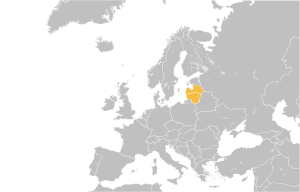
The Balts or Baltic peoples (Lithuanian: baltai, Latvian: balti) are a group of peoples inhabiting the eastern coast of the Baltic Sea who speak Baltic languages. Among the Baltic peoples are modern-day Lithuanians (including Samogitians) and Latvians (including Latgalians) — all East Balts — as well as the Old Prussians, Curonians, Sudovians, Skalvians, Yotvingians and Galindians — the West Balts — whose languages and cultures are now extinct, but made a large influence on the living branches, especially on literary Lithuanian language.
The Balts are descended from a group of Proto-Indo-European tribes who settled the area between the lower Vistula and southeast shore of the Baltic Sea and upper Daugava and Dnieper rivers, and which over time became differentiated into West and East Balts. In the fifth century CE, parts of the eastern Baltic coast began to be settled by the ancestors of the Western Balts, whereas the East Balts lived in modern-day Belarus, Ukraine and Russia. In the first millennium CE, large migrations of the Balts occurred. By the 13th and 14th centuries, the East Balts shrank to the general area that the present-day Balts and Belarusians inhabit. (Full article...) -
Image 8
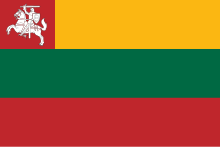
The Kingdom of Lithuania was an attempt to establish an independent constitutional Lithuanian monarchy in February 1918. It was created towards the end of World War I when Lithuanian-speaking lands were under military occupation by the German Empire. The state was officially dissolved in November 1918.
The Council of Lithuania declared Lithuania's independence on 16 February 1918, but the council was unable to form a government, police, or other state institutions due to the continued presence of German troops. The Germans presented various proposals to incorporate Lithuania into the German Empire, particularly Prussia. The Lithuanians resisted this idea and hoped to preserve their independence by creating a separate constitutional monarchy. (Full article...) -
Image 9
King Stanisław August Poniatowski unwillingly presided over the dissolution of the Polish–Lithuanian Commonwealth
The History of the Polish–Lithuanian Commonwealth (1764–1795) is concerned with the final decades of existence of the Polish–Lithuanian Commonwealth. The period, during which the declining state pursued wide-ranging reforms and was subjected to three partitions by the neighboring powers, coincides with the election and reign of the federation's last king, Stanisław August Poniatowski.
During the later part of the 18th century, the Commonwealth attempted fundamental internal reforms. The reform activity provoked hostile reaction and eventually military response on the part of the surrounding states. The second half of the century brought improved economy and significant growth of the population. The most populous capital city of Warsaw replaced Danzig (Gdańsk) as the leading trade center, and the role of the more prosperous urban strata was increasing. The last decades of the independent Commonwealth existence were characterized by intense reform movements and far-reaching progress in the areas of education, intellectual life, arts and sciences, and especially toward the end of the period, evolution of the social and political system. (Full article...) -
Image 10The history of Lithuania between 1219 and 1295 concerns the establishment and early history of the first Lithuanian state, the Grand Duchy of Lithuania. The beginning of the 13th century marks the end of the prehistory of Lithuania. From this point on the history of Lithuania is recorded in chronicles, treaties, and other written documents. In 1219, 21 Lithuanian dukes signed a peace treaty with Galicia–Volhynia. This event is widely accepted as the first proof that the Baltic tribes were uniting and consolidating. Despite continuous warfare with two Christian orders, the Livonian Order and the Teutonic Knights, the Grand Duchy of Lithuania was established and gained some control over the lands of Black Ruthenia, Polatsk, Minsk, and other territories east of modern-day Lithuania that had become weak and vulnerable after the collapse of Kievan Rus'.
The first ruler to hold the title of Grand Duke was Mindaugas. Traditionally he is considered the founder of the state, the one who united the Baltic tribes and established the Duchy. Some scholars, however, challenge this perception, arguing that an organized state existed before Mindaugas, possibly as early as 1183. After quelling an internal war with his nephews, Mindaugas was baptized in 1251, and was crowned as King of Lithuania in 1253. In 1261, he broke the peace with the Livonian Order, perhaps even renouncing Christianity. His assassination in 1263 by Treniota ended the early Christian kingdom in Lithuania. For another 120 years Lithuania would remain a pagan empire, fighting against the Teutonic and Livonian Orders during the Northern Crusades during their attempts to Christianize the land. (Full article...) -
Image 11The Narva culture or eastern Baltic was a European Neolithic archaeological culture in present-day Estonia, Latvia, Lithuania, Kaliningrad Oblast (former East Prussia), and adjacent portions of Poland, Belarus and Russia. A successor of the Mesolithic Kunda culture, the Narva culture continued up to the start of the Bronze Age. The culture spanned from c. 5300 to 1750 BC. The technology was that of hunter-gatherers. The culture was named after the Narva River in Estonia. (Full article...)
-
Image 12
The Act of Independence of Lithuania (Lithuanian: Lietuvos Nepriklausomybės Aktas) or the Act of February 16th, also the Lithuanian Resolution on Independence (Lithuanian: Lietuvos Nepriklausomybės Nutarimas), was signed by the Council of Lithuania on February 16, 1918, proclaiming the restoration of an independent State of Lithuania, governed by democratic principles, with Vilnius as its capital. The Act was signed by all twenty representatives of the Council, which was chaired by Jonas Basanavičius. The Act of February 16 was the result of a series of resolutions on the issue, including one issued by the Vilnius Conference and the Act of January 8. The path to the Act was long and complex because the German Empire exerted pressure on the Council to form an alliance. The Council had to carefully maneuver between the Germans, whose troops were present in Lithuania, and the demands of the Lithuanian people.
The immediate effects of the announcement of Lithuania's re-establishment of independence were limited. Publication of the Act was prohibited by the German authorities, and the text was distributed and printed illegally. The work of the Council was hindered, and Germans remained in control over Lithuania. The situation changed only when Germany lost World War I in the fall of 1918. In November 1918 the first Cabinet of Lithuania was formed, and the Council of Lithuania gained control over the territory of Lithuania. Independent Lithuania, although it would soon be battling the Wars of Independence, became a reality. (Full article...) -
Image 13
The Soviet occupation of the Baltic states covers the period from the Soviet–Baltic mutual assistance pacts in 1939, to their invasion and annexation in 1940, to the mass deportations of 1941.
In September and October 1939 the Soviet government compelled the much smaller Baltic states to conclude mutual assistance pacts which gave the Soviets the right to establish military bases there. Following invasion by the Red Army in the summer of 1940, Soviet authorities compelled the Baltic governments to resign. The presidents of Estonia and Latvia were imprisoned and later died in Siberia. Under Soviet supervision, new puppet communist governments and fellow travelers arranged rigged elections with falsified results. Shortly thereafter, the newly elected "people's assemblies" passed resolutions requesting admission into the Soviet Union. In June 1941 the new Soviet governments carried out mass deportations of "enemies of the people". Consequently, at first many Balts greeted the Germans as liberators when they occupied the area a week later. (Full article...) -
Image 14
The monarchy of Lithuania concerned the monarchical head of state of Lithuania, which was established as an absolute and hereditary monarchy. Throughout Lithuania's history there were three ducal dynasties—the House of Mindaugas, the House of Gediminas, and the House of Jagiellon. Despite this, the one and only crowned king of Lithuania was King Mindaugas I. In two more instances, royal nobles were not crowned due to political circumstances, but held de jure recognition abroad —Vytautas the Great by Sigismund, Holy Roman Emperor, and Mindaugas II by Pope Benedict XV.
Others were seen as kings of Lithuania even though they had only considered it and never took further action to claim the throne, as in the case of Gediminas who was recognised as king of Lithuania by Pope John XXII. The hereditary monarchy in Lithuania was first established in the 13th century during the reign of Mindaugas I and officially re-established as a constitutional monarchy on 11 July 1918, only to be abandoned soon afterwards on 2 November 1918. (Full article...) -
Image 15
Yotvingia or Sudovia (Yotvingian: Sūdava, Lithuanian: Dainava, Polish: Jaćwież, German: Sudauen, Eastern Slavic: Яцьвезь (Ятвязь, Етвязь), Ятвягия) was a region where the Baltic tribe known as Yotvingians lived. It was located in the area of Sudovia and Dainava; south west from the upper Nemunas, between Marijampolė, Merkinė (Lithuania), Slonim, Kobryn (Belarus), Białystok, and Ełk (Poland).
Today this area corresponds mostly to the Podlaskie Voivodeship of Poland, part of Lithuania and a part of Hrodna Province and Brest Province of Belarus. (Full article...)
Selected politics article
-
Image 1
Parliamentary elections were held in Lithuania on 9 and 23 October 2016 to elect the 141 members of the Seimas. 71 were elected in single-member constituencies using the two-round system, and the remaining 70 in a single nationwide constituency using proportional representation. The first round was held on 9 October and the second round on 23 October. (Full article...) -
Image 2

Lithuanian municipalities and elderships map
Lithuania is divided into three levels of administrative divisions. The first-level division consists of 10 counties (Lithuanian: singular – apskritis, plural – apskritys). These are sub-divided into 60 municipalities (Lithuanian: plural – savivaldybės, singular – savivaldybė), which in turn are further sub-divided into over 500 smaller groups, known as elderships (Lithuanian: plural – seniūnijos, singular – seniūnija). (Full article...) -
Image 3This article lists political parties in Lithuania.
Lithuania has a multi-party system with numerous political parties, in which no one party often has a chance of gaining power alone, and parties must work with each other to form coalition governments. As of October 2024[update], there are 22 active political parties, one party undergoing formal registration, one inactive political party, and four political parties that are in the process of disestablishment registered with the Ministry of Justice. (Full article...) -
Image 4
The Supreme Court of the Republic of Lithuania (Lithuanian: Lietuvos Respublikos Aukščiausiasis Teismas) is the only court of cassation in the Lithuania for reviewing effective judgements and rulings passed by the courts hearing criminal cases at the first and appeal instances as well as decisions and rulings in civil cases passed by the courts of appeals. It is the highest court of cassation, but it cannot interpret the constitution, since that is under the jurisdiction of the Constitutional Court of Lithuania. The current President of the Supreme Court of Lithuania is Danguolė Bublienė. (Full article...) -
Image 5
Gintaras Goda (Lithuanian: [ˈɡʲɪn̪t̪ɐrɐs ˈɡʲɐ̂ːd̪ɐ]; born 13 June 1965) is a Lithuanian judge, legal researcher, comparative criminal procedure expert and professor at the Faculty of Law of Vilnius University who is currently serving as President of the Constitutional Court of Lithuania since 2023. He had been a Judge of the Supreme Administrative Court of Lithuania from 2002 to 2005 and was Judge of the Supreme Court of Lithuania from 2005 to 2017. (Full article...) -
Image 6
The President of the Supreme Court of Lithuania (Lithuanian: Lietuvos Aukščiausiojo Teismo Pirmininkas) is the President or chief justice of the Supreme Court of Lithuania. The president is regarded as one of two equivalent heads of judicial branch in Government of Lithuania. Another head is the president of the Constitutional Court of Lithuania. The current President of the Supreme Court of Lithuania is Incumbent Danguolė Bublienė. (Full article...) -
Image 7
The president of the Republic of Lithuania (Lithuanian: Lietuvos Respublikos Prezidentas) is the head of state of the Republic of Lithuania. The president directs and appoints the executive branch of the Government of Lithuania, represents the nation internationally and is the commander-in-chief of the Lithuanian Armed Forces. The president is directly elected by the citizens of Lithuania for a five-year term, with the office holder limited to serving two terms consecutively. The current president is Gitanas Nausėda who assumed office on July 12, 2019. (Full article...) -
Image 8
Seimas Palace (Lithuanian: Seimo rūmai) is the seat of the Seimas, the Lithuanian parliament. It is located in Lithuania's capital Vilnius. (Full article...) -
Image 9
Danguolė Bublienė is a Lithuanian lawyer and judge who is currently serving as the President of the Supreme Court of Lithuania. She is the first woman to hold this position in the history of the Lithuanian judiciary. Her career spans various legal roles, where she has earned recognition for her expertise in civil law and her commitment to ensuring justice. (Full article...) -
Image 10
The Speaker of the Seimas (Lithuanian: Seimo pirmininkas, literally translated as Chairman of the Seimas) is the presiding officer of the Seimas, the parliament of Lithuania. The speaker and deputy speakers are elected by the members of the Seimas during the session. (Full article...) -
Image 11In Lithuania, a public election committee (Lithuanian: visuomeninis rinkimų komitetas) is an organized group of voters outside of political parties which participates in local or European Parliament elections. (Full article...)
-
Image 12

The Prosecutor General of Lithuania (Lithuanian: Lietuvos Generalinis Prokuroras) is the chief and head of the Prosecutor General's Office of Lithuania and is the highest-ranking official within the Lithuanian prosecutorial system. The current incumbent is Nida Grunskienė. (Full article...) -
Image 13
Nida Grunskienė (Lithuanian: [/ˈnɪdɐ ˈɡrʊnˌskʲɛːnʲɛ/]; born 21 May 1969) is a Lithuanian jurist and legal expert who has been serving as the Prosecutor General of Lithuania since 14 January 2021. She also served as the Chief Prosecutor of the Panevėžys Regional Prosecutor’s Office from 2013 to 2021, where she gained extensive experience in handling criminal cases, particularly in the areas of organized crime and corruption. (Full article...) -
Image 14Taxes in Lithuania are levied by the central and the local governments. Most important revenue sources include the value added tax, personal income tax, excise tax and corporate income tax, which are all applied on the central level. In addition, social security contributions are collected in a social security fund, outside the national budget. Taxes in Lithuania are administered by the State Tax Inspectorate, the Customs Department and the State Social Insurance Fund Board. In 2019, the total government revenue in Lithuania was 30.3% of GDP. (Full article...)
-
Image 15There have been fifteen referendums in Lithuania since it declared independence from the Soviet Union on 11 March 1990. Because of strict requirements, only four referendums have been successful. Older Lithuanian laws required that more than half of all registered voters (not half of voters who participate) would vote in support of a proposal for it to become a binding obligation to the government. In 2002, this requirement was lowered to one third of all registered voters. (Full article...)
Selected biography
-
Image 1

Algirdas Kaušpėdas (born 12 August 1953, in Vilnius, Lithuania) is a Lithuanian rock musician, the leader of Lithuanian rock group Antis, an architect, and one of the Sąjūdis initiators. His wife Vilija Ulozaitė is also an architect. (Full article...) -
Image 2Edita Daniūtė (born 1 July 1979 in Vilnius, Lithuania) is a professional Lithuanian ballroom dancer and television presenter.
Until 2007 she was competing with her partner Arūnas Bižokas as a couple; they won the World Games in 2005. In 2007 Bižokas transferred to the IOC non-recognized WDC and started representing the USA. Daniūtė started competing with Italian dancer Mirko Gozzoli in November 2009 under the Lithuanian flag. As a couple they become World and European champions in 2013 & 2014. They were married on June 15, 2019. Edita Daniūtė was television presenter in the dance show "Šok su žvaigždė" that aired on LNK. (Full article...) -
Image 3

Kazimira Danutė Prunskienė (; born 26 February 1943) is a Lithuanian politician who was the first prime minister of Lithuania after the declaration of independence on 11 March 1990, and then Minister of Agriculture in the government of Gediminas Kirkilas.
She was the leader of the Peasants and New Democratic Party Union and the Lithuanian People's Party. From 1981 to 1986 she worked in West Germany. (Full article...) -
Image 4Kazimieras "Kazim" Vasiliauskas (born 2 August 1990) is a Lithuanian former racing driver. (Full article...)
-
Image 5
Romualdas Marcinkus (22 July 1907 – 29 March 1944) was a Lithuanian pilot. Marcinkus participated in an early trans-European flight on 25 June 1934, and was the only Lithuanian pilot to serve in the Royal Air Force (RAF) during the Second World War. In his youth Marcinkus was a Lithuanian multifold football champion and a playing coach for the Lithuania national football team.
While serving in the Lithuanian Air Force, Marcinkus was a parachute instructor, and headed the aviation sport and physical education department, and during his later years coached a junior football team. A few months before the Soviet occupation of Lithuania early in the Second World War, Marcinkus left Lithuania and enlisted in the French Air Force. After the Battle of France and the French capitulation, Marcinkus escaped to Britain, where he flew for the RAF. As a pilot for No. 1 Squadron RAF, he took part in various missions, including escorting bombers and night combat. On 12 February 1942, during Operation Cerberus, he was shot down, became a prisoner of war, and was sent to Stalag Luft III. (Full article...) -
Image 6Ruta Lee attending ceremony for Leslie Caron's star on the Hollywood Walk of Fame, December 8, 2009
Ruta Lee (born Ruta Mary Kilmonis; May 30, 1935) is a Canadian-born American actress and dancer of Lithuanian descent. She was born in Montreal, Canada, to Lithuanian immigrant parents. Ruta Lee appeared as one of the brides in the musical Seven Brides for Seven Brothers. She had roles in films including Billy Wilder's crime drama Witness for the Prosecution and Stanley Donen's musical comedy Funny Face, and also is remembered for her guest appearance in a 1963 episode of Rod Serling's sci-fi series The Twilight Zone called "A Short Drink from a Certain Fountain".
Lee guest-starred on many television series, and was also featured on a number of game shows, including Hollywood Squares, What's My Line?, and Match Game, and as Alex Trebek's co-host on High Rollers. (Full article...) -
Image 7

Self-portrait (date unknown)
Jan Rustem (Armenian: Յան Ռուստամ; 1762 – 21 June 1835) was a painter of Armenian ethnicity who lived and worked in the territories of the Polish–Lithuanian Commonwealth. Primarily a portrait painter, he was commissioned to execute portraits of notable personalities of his epoch. For many years he was a professor at Vilnius University. (Full article...) -
Image 8
Simonas Daukantas (Polish: Szymon Dowkont; 28 October 1793 – 6 December 1864) was a Lithuanian/Samogitian historian, writer, and ethnographer. One of the pioneers of the Lithuanian National Revival, he is credited as the author of the first book on the history of Lithuania written in the Lithuanian language. Only a few of his works were published during his lifetime and he died in obscurity. However, his works were rediscovered during the later stages of the National Revival. His views reflected the three major trends of the 19th century: romanticism, nationalism, and liberalism.
Daukantas was born in Samogitia to a Lithuanian family. Likely a son of free peasants, he later produced proof of his noble birth to get university degree and a promotion in his government job. He attended schools in Kretinga and Žemaičių Kalvarija and was noted as an excellent student. Daukantas studied law at the University of Vilnius, though his interest lay in philology and history. After the graduation, he worked as a civil servant of the Russian Empire from 1825 to 1850. He first worked at the office of the Governor-General of Livonia, Estonia and Courland in Riga then moved to Saint Petersburg to work at the Governing Senate. At the Senate, he had the opportunity to study the Lithuanian Metrica, the state archive of the 14–18th century legal documents of the Grand Duchy of Lithuania. In 1850, Daukantas retired from his job due to poor health and moved back to Samogitia where he lived in Varniai under the care of bishop Motiejus Valančius for a few years. He hoped to publish some of his works with bishop's help, but the bishop prioritized religious work and they began to quarrel. In 1855, Daukantas moved to Jaunsvirlauka [lv] in present-day Latvia and later to Papilė where he died in obscurity in 1864. (Full article...) -
Image 9Probability theory or probability calculus is the branch of mathematics concerned with probability. Although there are several different probability interpretations, probability theory treats the concept in a rigorous mathematical manner by expressing it through a set of axioms. Typically these axioms formalise probability in terms of a probability space, which assigns a measure taking values between 0 and 1, termed the probability measure, to a set of outcomes called the sample space. Any specified subset of the sample space is called an event.
Central subjects in probability theory include discrete and continuous random variables, probability distributions, and stochastic processes (which provide mathematical abstractions of non-deterministic or uncertain processes or measured quantities that may either be single occurrences or evolve over time in a random fashion).
Although it is not possible to perfectly predict random events, much can be said about their behavior. Two major results in probability theory describing such behaviour are the law of large numbers and the central limit theorem. (Full article...) -
Image 10

Edward Stephen Waitkus (September 4, 1919 – September 16, 1972) was a Lithuanian American professional baseball player who played as a first baseman. He played a total of 11 seasons in Major League Baseball (MLB), before and after serving in World War II (1941 and 1946–1955). He played for the Chicago Cubs and Philadelphia Phillies in the National League and for the Baltimore Orioles of the American League. He was elected to the National League All-Star team twice (1948 and 1949). (Full article...) -
Image 11

Stasys Girėnas (known as Stanley T. Girenas in the US; born Stasys Girskis; October 4, 1893 in Vytogala, Kovno Governorate – July 17, 1933 near Soldin, Germany) was a Lithuanian-American pilot, who died in a non-stop flight attempt with the Lituanica from New York City to Kaunas, Lithuania, in 1933. (Full article...) -
Image 12Jillian at the 1988 Emmy Awards
Ann Jillian (born Ann Jura Nauseda; January 29, 1950) is a former American actress and singer whose career began as a child actress in 1960. She is best known for her role as the sultry Cassie Cranston on the 1980s sitcom It's a Living. (Full article...) -
Image 13Vytautas Straižys (20 August 1936 – 19 December 2021) was a Lithuanian astronomer. In 1963–65 he and his collaborators created and developed the Vilnius photometric system, a seven-color intermediate band system, optimized for photometric stellar classification. In 1996 he was elected a Corresponding Member of the Lithuanian Academy of Sciences. Straižys was an editor of the journal Baltic Astronomy. He spent a lot of time working at the Molėtai Astronomical Observatory. Asteroid 68730 Straizys in 2002 was named after him. (Full article...)
Associated Wikimedia
The following Wikimedia Foundation sister projects provide more on this subject:
-
Commons
Free media repository -
Wikibooks
Free textbooks and manuals -
Wikidata
Free knowledge base -
Wikinews
Free-content news -
Wikiquote
Collection of quotations -
Wikisource
Free-content library -
Wikiversity
Free learning tools -
Wikivoyage
Free travel guide -
Wiktionary
Dictionary and thesaurus



































![Image 36The earliest known Lithuanian glosses (between 1520 and 1530) written in the margins of Johann Herolt book Liber Discipuli de eruditione Christifidelium. Words: teprÿdav[ſ]ʒÿ (let it strike), vbagÿſte (indigence). (from Lithuania)](http://up.wiki.x.io/wikipedia/commons/thumb/f/f6/The_earliest_known_Lithuanian_glosses_%28~1520%E2%80%931530%29%2C_words_%28tepridau%C5%BEia%2C_ubagyst%C4%97%29.jpg/120px-The_earliest_known_Lithuanian_glosses_%28~1520%E2%80%931530%29%2C_words_%28tepridau%C5%BEia%2C_ubagyst%C4%97%29.jpg)














































